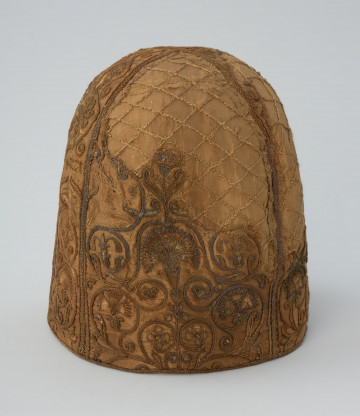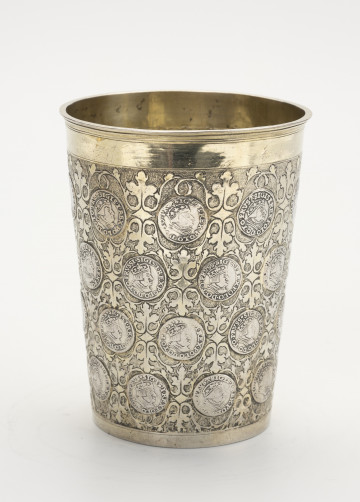
Cap
około 1600
National Museum in Szczecin
Part of the collection: Jewels and costumes of Pomeranian dukes
Caps - high headgear, often with a rim - became fashionable in the last quarter of the 16th century on the wave of then interest in the Middle East. In inventories, they were not usually called hats but caps. Sometimes they were also referred to as 'Polish caps'. Among the caps excavated from the ducal crypt under the castle church in Szczecin, two embroidered specimens stand out for their high quality of artistry. Researchers identified one of them as belonging to Philip II, based on comparison with the Duke's posthumous image known from archival photographs.Philip II's cap was sewn from velvet, originally black. The gold embroidery of a linear, plant-geometric pattern, with a distinctive carnation motif, created a stunning effect against the black. Today, the thread braid is chipped chiefly, and many gold sequins are missing, but the embroidery has been preserved in its entirety and still looks very impressive. Thanks to the posthumous portrait and the description of the funeral ceremony, it is known that Philip II's cape was decorated with several gold, diamond and pearl jewels (two of them found in the crypt of the Castle Church are in the collection of the National Museum in Szczecin), and a tuft of black heron feathers. The gold embroidery and jewels emphasised the splendour of power, while the black of the velvet and feathers on the cape gave the outfit a solemnity appropriate to the nature of the funeral ceremony.
Monika Frankowska-Makała
Author / creator
Dimensions
cały obiekt: height: 28 cm
Creation time / dating
Creation / finding place
Identification number
Location / status

około 1600
National Museum in Szczecin

1680 — 1700
National Museum in Szczecin

1690 — 1710
National Museum in Szczecin
DISCOVER this TOPIC
National Museum in Szczecin
DISCOVER this PATH
Educational path